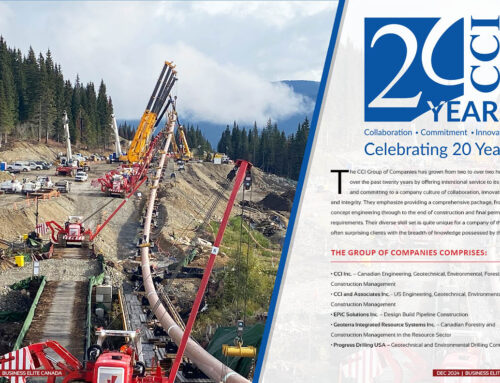Each year, Mosaic—one of the world’s largest producers of potash and phosphate fertilizer—mines, produces and distributes millions of tonnes of high-quality potash and phosphates products. Without fertilizers, the world’s crop yields would be cut in half, and farmers around the world look to Mosaic to help keep their soils healthy, to nourish their crops and to maximize their yields.
In February 2017, Business Elite Canada wrote about Mosaic when the company’s facility in Esterhazy, Saskatchewan hit a significant project milestone in the Esterhazy K3 project, touted to be the largest, most competitive underground potash mine in the world. Nearly five years later, and the K3 project’s newly completed south shaft headframe is operating at full hoisting capacity; production officially began November 8 following successful commissioning of the headframe and ore handling system in October, 2021.
As planned, hoisting capacity of the south shaft headframe started at 10,000 tons per day and increased to 40,000 tons per day in December. Combined with the north shaft headframe, which has been in operation since 2018, this will bring K3’s hoisting capacity to more than 80,000 tons per day.
K3—The Future of Potash
The K3 mega-project includes Saskatchewan’s first new underground potash mine in over a half-century. This $3 billion-dollar project, which kicked off in 2009, is an investment in the long-term sustainability of Mosaic’s operations, Esterhazy, the Province and the vision they have for Mosaic’s North America Business. It also brought significant capital investment and contract work to the area.
“Potash has a rich history in Esterhazy, and this project represents Mosaic’s commitment to continuing that success for decades to come,” says Dustin Maksymchuk, General Manager, Esterhazy. “We’re proud of the future we’re building for Mosaic, for our employees and for the communities we live in.”
The Importance of Potash
According to United Nations estimates, the world needs to grow 70 per cent more food by 2050. Canadian potash is helping make that possible and currently leading the world in global potash production.
Potash is the second most valuable metal/mineral product in Canada—trailing only gold. “The industry contributes more than $5.5 billion annually to Canada’s Gross Domestic Product and more than $500 million in federal, provincial and local taxes,” says Maksymchuk. “There are more than 5,000 jobs in the potash mining industry and for every one of those jobs, there are at least two in the mining supply and service sector. These jobs provide more than one billion in wages annually. Mosaic and other potash producers also invest millions of dollars annually in local communities.”
The K3 project required in excess of 12.5 million person-hours to execute, and there were up to 500 people on site per day during peak construction periods, says Bernie Boutin, Director of Capital Projects –K3. “With a project of this magnitude and duration, safety is always top of mind. Thousands of contractors and Mosaic employees have worked on different aspects of the project, and we are truly grateful for their hard work and dedication. The focus has always been on safe project execution so everyone can return home safely to family and friends.”
So how did Mosaic manage to sink shafts 20-foot in diameter 3,500 feet into the ground? A combination of sinking winches and hoists located at surface, and the respective hoist ropes operated through the permanent north headframe, and the temporary south sinking headframe, is the answer.
“A five-level galloway structure was utilized in both the north and south shafts, and it functioned as a working stage for both personnel and equipment,” Boutin explains. “The conventional drilling and blasting method was used to sink the 20 ft diameter shafts through the bare earth. An excavator suspended below both galloways and was used to load the blasted muck into buckets that were hoisted to surface. When the shaft wall was exposed, a shaft wall liner was constructed as the shaft sinking advanced.”
Esterhazy K3’s North shaft headframe began production in January 2019. It is used to move potash ore to the surface and transport people and equipment, says Boutin. The K3 South shaft headframe, which is used solely to move potash ore to the surface, began production in November 2021. As of the end of March 2022, there are a total of nine mining machines cutting underground at K3 that can provide an average of 50,000 ore tons per day. Another mining machine is nearing production, and three more mining machines and more underground conveyors will be added over the next couple years.
“A fully operational Esterhazy K3 is improving the profitability and competitiveness of our business—solidifying our position as an industry leader and allowing us to find new, innovative ways to deliver on Mosaic’s commitments to our customers, communities, employees and other stakeholders,” says Maksymchuk.
Mosaic is among the most reliable, sustainable producers of potash fertilizer in the world, and completion of the K3 project will allow Mosaic to fully leverage existing assets and make the best possible use of Esterhazy’s rich potash ore reserves.
For more information, visit www.timetodigdeeper.com | www.mosaicincanada.com






